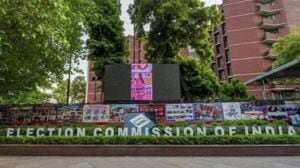On the ground, why encroachments in Delhi’s Ridge keep ‘returning’
In this matter, the Deputy Conservator of Forest, South Forest Division, filed a status report in April this year after an inspection.
 A board placed at Bhatti Mines. (Express Photo by Praveen Khanna)
A board placed at Bhatti Mines. (Express Photo by Praveen Khanna)Over the years, clearing encroachments on land in the Ridge forest area has been no easy task for Forest Department officials. In some cases, there are stay orders from the court. Sometimes, encroachments are removed — only to crop up again.
Devinder, a resident of Asola who is in his early 50s, is sure that most farmhouses and establishments in Asola are younger than he is. “We began to see construction… farmhouses and others… in the 1980s,” he said.
Concerned about Asola’s forest area, particularly the wildlife sanctuary, he filed a petition in the HC in 2016, flagging “unauthorized construction.” The court asked the Delhi government to ensure there is no further encroachment in the area notified as sanctuary. In July 2017, the government told the court a demolition drive was fixed in Asola beginning later that month.
In 2019, Devinder’s lawyer told the court that despite its orders, the encroached area has not been freed; in areas where partial demolition was carried out, encroachers have returned. In 2022, he told the court that though unauthorized construction was removed from two patches of land in Asola, the areas have been encroached upon again.
In March this year, he told the court that there’s been “perfunctory clearance of small shanties etc., but bigger farmhouses and other buildings have not been removed/demolished.”
In this matter, the Deputy Conservator of Forest, South Forest Division, filed a status report in April this year after an inspection. Of the 7 khasra numbers Devinder had flagged in Asola, four were marked as having “heavy encroachment on the ground”; three were identified as “farmhouse encroachment”.
Among those marked as “heavy encroachment” was a row of buildings, some multi-storey, with shops on the ground floor and homes above on Sant Shree Nagpal Marg, a busy main road, near Fatehpur Beri. One of these is a motorcycle showroom. “Some of these buildings came up in 2019-20; it was not as heavily built up in the years before,” Devinder said. As for the farmhouses, he said demolition was carried out in parts of those properties in 2017.
While the inspection report said demolition drives were fixed in two out of three of these areas in April this year, a forest department official said it was not carried out: “With farmhouses, there is also the issue of entry into the property. In the case of a farmhouse in Bhatti, we tried initiating demolition in 2021, but the path to the patch of forest land is through their property, and they called the police to tell us we can’t enter private land.”
Some farmhouses have bo-ards outside that specify they have a stay from a court. These stand within tall walls topped with concertina wire and sturdy gates, behind which buildings are difficult to spot.
Some, like a piece of land in Bhatti, around 100 m away from the sanctuary wall, don’t have construction within and comprise walls and a gate — structures that the department’s staff is more confident about entering when they prepare a schedule for further demolitions.
Where court stays protect some properties, others have been razed either by the Forest Department or other agencies like the Delhi Development Authority; earlier this year, the DDA demolished the Akhoondji mosque and a madrasa in the reserved forest area of Sanjay Van.
As for demolitions by the department in 2023, khasra numbers where action (spread out over October, November and December) was initiated mostly correspond to those marked as ‘unauthorized colony’ in the list of encroachments.
In Neb Sarai (where multi-storey buildings marked as an unauthorized colony near Freedom Fighters Enclave were demolished), Aya Nagar, Bhatti, Chattarpur, and Satbari, unauthorized colonies were acted upon. Only in Asola, action over the past year has been exclusively on farmhouses.
Of around 379 hectares identified as encroached in the South forest division, 181.51 hectares comprise unauthorized colonies. Of the villages, Bhatti has the largest area, 59.49 hectares, under unauthorized colony encroachment, followed by Devli with 37.05 hectares.
With no plan for rehabilitation in place, it will be difficult for the department to act on densely populated unauthorized colonies, a senior forest official said, adding that there is no mechanism by which colonies on forest land can be regularised. They will have to be demolished eventually, considering court orders that require forest land to be cleared of encroachments.
The Forest Department has not responded to questions seeking official comment.












